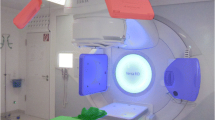Summary
For stereotactic biopsy, intracavitary and interstitial irradiation of intracranial tumours, stereotactic CT investigations are of utmost importance. Targetpoints within a tumour as well as the tumour-outlines have to be transferred precisely from transverse and longitudinal CT sections to stereotactic X-ray images. For this purpose, the stereotactic apparatus of Riechert and Mundinger has been equipped with a fixation system of carbon fibre and a measuring phantoma of plexiglass with embedded steel wires allowing stereotactic CT scanning without artefacts. The stereotactic coordinates (x, y, z) of any target point can be taken directly from transverse CT images with high accuracy. The tumour outlines can be transferred to the stereotactic coordinate system from longitudinal CT reconstructions using special computer programmes. Precise transfer is possible if the CT investigation is performed stereotactically.
Similar content being viewed by others
References
Birg, W., Mundinger, F., Parameters for polar-coordinate stereotactic devices, the direct target point determination for stereotactic brain operations from CT-data and the calculation of setting parameters for polar-coordinate stereotactic devices. 8th Meeting of the World Society and 5th Meeting of the European Society for stereotactic and functional neurosurgery. Zürich, 9.–11. 7. 1981, Appl. Neurophysiol. 45.
Boethius, J., Bergstrom, M., Greitz, T., Stereotactic computerized tomography with a Ge 8800 scanner. J. Neurosurg.52 (1980), 794–800.
Brown, R. A., A computerized tomography-computer graphics approach to stereotaxic localization. J. Neurosurg.50 (1979), 715–720.
Cohadon, F., Rougier, A., da Silva Nunes Neto, D., Pigneux, J., Caillé, J. M., Constant, P., La tomodensitométrie en conditions stéréotaxiques. Neurochir.23 (1977), 433–452.
Leksell, L., Jernberg, B., Stereotaxis and tomography. Acta neurochir. (Wien)52 (1980), 1–7.
Riechert, T., Mundinger, F., Beschreibung und Anwendung eines Zielgerätes für stereotaktische Hirnoperationen (II. Modell). Acta neurochir. (Wien), Suppl. III (1955), 308–337.
Schlegel, W., Scharfenberg, H., Sturm, V., Penzholz, H., Lorenz, W. J., Direct visualization of intracranial tumours in stereotactic and angiographic films by computer calculation of longitudinal CT sections: A new method for stereotactic localization of tumour outlines. Acta neurochir. (Wien)58 (1981), 27–35.
Wise, B. L., Gleason, C., CT directed stereotactic surgery for diagnosis and treatment of deep cerebral lesions. Annual Meeting of A.A.N.S., Los Angeles, Cal. (1979).
Author information
Authors and Affiliations
Additional information
Dedicated to Prof. Dr. O. Westphal on the occasion of his 70th birthday.
Rights and permissions
About this article
Cite this article
Sturm, V., Pastyr, O., Schlegel, W. et al. Stereotactic computer tomography with a modified Riechert-Mundinger device as the basis for integrated stereotactic neuroradiological investigations. Acta neurochir 68, 11–17 (1983). https://doi.org/10.1007/BF01406197
Issue Date:
DOI: https://doi.org/10.1007/BF01406197




